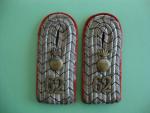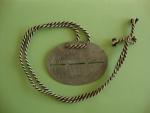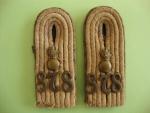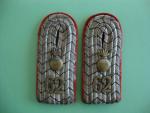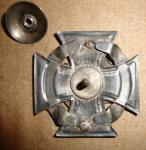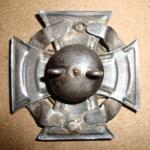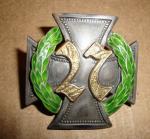-
Posts
125 -
Joined
-
Last visited
-
Days Won
1
Content Type
Profiles
Forums
Blogs
Gallery
Events
Store
Everything posted by AOK4
-
Lange's shoulder boards from Leichte Munitionskolonne 878. They have a fieldgray backing. Leichte Munitionskolonne 878 was created on 5 February 1917 by the Heeresgruppe Eichhorn (Ukraine), from the former Leichte Munitionskolonne der III. Abteilung/Feldartilerie-Regiment 1. The unit was attached to the 8. Armee until April 1918, when it was put under command of II/Feldartillerie-Regiment 38 (also in Ukraine).
-
Hello, I managed to buy two pairs of shoulder boards and two ID discs from one man (a real attic find probably as there is still bits of mold here and there). Feldwebelleutnant Fritz Lange Hoya an der Weser, Kreis Bremen 15.2.1879 Feldartillerie-Regiment 62 later Leichte Munitions-Kolonne 878, Nr. 3a The first pic shows the Feldwebelleutnant's shoulder boards (similar as Leutnant's shoulder boards) from FAR 62 with the field artillery red backing. FAR 62 belonged to the 19. Infanterie-Division from the outbreak of the war until late 1916, when it was transferred to the XII. Reservekorps. From late February 1917 on, it was then attached to the 238. Infanterie-Division as divisional field artillery regiment.
-
I think the men of Landsturm Battalion Chemnitz XIX/11 were just a patrol to protect or search for something, as they never saw frontline action, they were guarding the rear areas of the 4th Army, Armee-Abteilung C, Heeresgruppe Kronprinz and 7th Army during the war. The 1st Company served as a guard for a French POW company. No need for stormtroops there at all. The armbands may be related to the guarding of POWs as these wore (yellow) armbands as well.
-
Another view of the back with the silver hallmarks. W.P. stands for the jeweller Pettersson from Turku (Abo) who made most of the early pieces. O5 stands for 1919, the year in which this badge was made.
-
View of the back with screwback. Originally, the badges were made with 4 needles. Since that system didn't work very well, most of the badges were later changed into or made with screwbacks or pins. Unfortunately no number on the back.
-
Of course. This is a close up of the front. You see the iron cross shape, referring to the unit being a German unit and the "27" made out of two 7's since the stock of 2's was completely sold out when the unit was officially named Jäger-Bataillon 27. This problem was then solved by using a reversed 7 as a 2 on the shoulder boards etc. The badge was drawn by Mrs. Ellinor Ivalo. App. 1800 pieces were awarded, also to a few Germans who had been connected to the Battalion, mostly as training officers etc. They pop up every now and then on the market, even though most of them are kept in (semi-)official museums and within the families.
-
Look here: http://www.hermann-historica.de/auktion/hhm58.pl?f=NR&c=94625&t=temartic_A_D&db=kat58_a.txt The medal bar was sold for only 3.300 euros two years ago!!!! If you think of the uniqueness of the combination, it is a bargain... (especially if you compare this to a Victoria Cross or something similar...) Unbelievable...
-
14.IV. 17. Sende ich Ihnen die besten Grüße und teile Ihnen mit, daß ich seit 10. d. Mts. [10. des Monats] in der Heimat bin und zwar im Vereinslazarett St. Ottilien in Oberbayern in der Hoffnung, daß sie meine Karte bei bester Gesundheit antrifft verbleibe Ihr Vizefeldwebel Jörg ??? (Added and corrected some things)
-
Indeed. BTW, I've seen other pics on eBay showing Landsturm soldiers in quiet sectors, being completely dressed up as real storm troopers with top equipment before. Either they could get that kind o equipment easier because of the quiet sectors (and the small danger of it being captured by enemy raids) or they loved more being photographed with it...
-
As I wrote, some higher officers did not accept EK1 for staff officers etc., others did. I encountered a case where a staff officer applied for a EK1 in 1918 for some alleged heroic deeds in 1915 and continuous staff work since then. This was bluntly refused by the divisional commander because, 1915 was too long ago and if he would have been entitled for a EK1 for those deeds, he should have gotten it then, and secondly because an EK1 wasn't meant to be given for staff work... Of course it all depended on the higher officer.
-

UK/US Gas Mask? - Identify this uniform
AOK4 replied to Chris Boonzaier's topic in The Great War 1914 to 1918
And no clue from which collection it came? My guts say, judging on the sandy environment, a pic from a British victim from the Operation Strandfest area (Belgian coast July 1917)... -

UK/US Gas Mask? - Identify this uniform
AOK4 replied to Chris Boonzaier's topic in The Great War 1914 to 1918
No other indications on the picture? I mean who took the picture and when?


